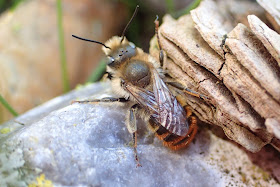I've just spent a very informative few days on Steven Falk's bee course hosted by the University of Sussex. The second I was able to guide people around Seaford Head and show everyone the fantastic work we have been doing there to improve the habitat for wildlife. The eastern ride in Hope Bottom is looking incredible at the moment (above) with a carpet of Ground-ivy flowering and a host of bees and flies feeding on it in the warmth of the sinuous ride. This was just solid scrub a few years ago. We got a big thumbs up from Steven for this. This is a great place to see Hairy-footed Flower Bee Anthophora plumipes (below) and Dotted Bee-fly.
You can see where it gets its English name from!
But things got really exciting when we got to Hope Gap and stopped for lunch. I was buzzed by a big shiny black bee and managed to net it. It was a male Black Mining-bee Andrena pilipes (my 35th Andrena - although I am already on 36 but that's another story!). A new species for me and a really scarce bee on the Downs. Although there is one record from Steven back in 2008 for this species, it may actually have been new for the reserve. I love Andrenas so finding a new one is always a great moment. I also caught a funny looking Nomada but hold that thought...
I think Special Ops Mining-bee also works.
We went down to the tiny saltmarsh area but it was quite exposed. I did find a male Osmia aurulenta though and it behaved for some photos after being potted.
We headed back via Hope Gap again to check out the carpets of Ground-ivy and someone caught another funny Nomada. Steven then got really excited, with this being possibly the first record for Sussex. In all we saw at least three Variable Nomad Bees Nomada zonata and I have just keyed out two specimens from what I had collected. Quite the day! This is the 10,094th species and the 471st hymenopteran recorded on a Sussex Wildlife Trust reserve.
Steven stayed on and found the first of the very rare Potter Flower Bee Anthophora retusa of the year (that the site is well known for and we'll be surveying for in a few weeks) and saw around ten Nomada zonata and has kindly let me use his photos here. A big thank you to Steven and Nick Balfour from the University of Sussex for such a great event.
Steven stayed on and found the first of the very rare Potter Flower Bee Anthophora retusa of the year (that the site is well known for and we'll be surveying for in a few weeks) and saw around ten Nomada zonata and has kindly let me use his photos here. A big thank you to Steven and Nick Balfour from the University of Sussex for such a great event.











Thanks for sharing this and the lovely photos. I'm still a novice bee-spotter but get equally excited whenever I see a species for the first time. Steven Falk's field guide is my bee bible, these days, but I also get some great assistance with IDs from Matt Smith and others via BWARS facebook group.
ReplyDelete